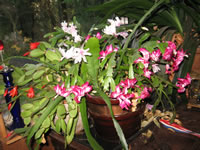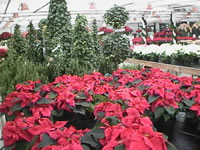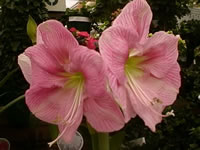|
Fall is the time to plant seeds for many different perennial plants and most spring flowering bulbs.
Perennial plants that have overgrown their space or have become crowded should be
dug and divided or moved to a new area of the garden.
New and replacement perennials can also be planted as long as the soil is workable.
Depending on your growing zone, tender bulbs like Dahlias may need to be dug up
and stored in a cool, dark area after first frost.
Dormant trees and flowering shrubs can be planted or transplanted later, in the coming months.
If you kept any of your house plants outdoors for the summer, be sure to bring them back indoors
before temperatures drop below 50° or if any frost is predicted in your area!
Protecting Plants from Frost
Weather conditions can bring about a frost, even in supposedly frost free areas.
It is important to heed the warning when your local forecaster announces 'a chance of frost',
and take precautions to protect your garden.
Often times it is possible to extend your growing season
by several weeks if you are able to keep your plants alive through an early frost!
|
|
Calendar of Gardening Tasks and Projects
For a complete guide of the important tasks, maintenance and projects
that should be done in your garden each month, check out the Gardening Calendars. These calendars were written primarily for gardeners in USDA Zones 7-8, but please don't let that stop you from reading if you happen to grow your garden in a colder or hotter region....
Gardening tasks are the same, no matter where you live. In other zones, they are just done in a different month! If you do your gardening is in cooler or warmer regions, browse the months before and after the current month for reminders of anything you forgot to do, and projects that you have to look forward to.
This should allow you to plan your seasonal gardening activities well in advance,
and help keep your plants and flowers looking their very best.
|
Winter Blooming House Plants
Christmas and Thanksgiving Cactus and Poinsettias are short day plants that bloom
in reaction to the natural shortening of the days in fall.
Holiday Cactus Schlumbergera Hybrids
Holiday Cactus are capable of blooming at almost any time of the year by manipulating their light and temperature. The natural changes of daylight hours will usually trigger blooming of these different Holiday Cactus to coincide with their named holiday.
In the fall, reduce watering and keep your Christmas Cactus cooler 60°-65° at night.
Protect from artificial light during night time hours.
Increase watering and resume feeding when the flower buds appear.
Christmas Cactus and other Holiday Cactus do not like to be moved to a different location once they set their buds. Rapid environmental changes can cause the flower buds to quickly drop. |
 |
Poinsettia Euphorbia pulcherrima
In order for you to 'set' the time of blooming for Christmas, Poinsettia plants must be subjected to 14 hours of total darkness per day with a night temperature of 50° beginning in mid-September.
This can be accomplished by placing your plant in a closet or unlit room, or by covering the plant with black cloth, black plastic frame or a cardboard box.
At this stage, ANY light, even turning on a light bulb in the room for a few seconds will delay the bloom for up to a day! Your Poinsettia plant should be returned to the light each day and given a minimum of 4 hours of direct sun. |
 |
Amaryllis Hippeastrum
Plant Amaryllis bulbs 8 weeks before you would like them to bloom.
Bulbs can be planted at two week intervals, from September through February
to ensure non-stop winter bloom, until May.
Plant in a well-drained, sterile potting medium, using a standard 6-inch diameter pot.
Be sure that the pot has adequate drainage holes. |
 |
Most of the photos you'll find here at The Garden Helper are of
plants and flowers growing here in the Gardens of Cedar Hill. Click on them to enlarge.
I hope that you enjoyed your visit to The Garden Helper!
Please come back again, soon...
|



